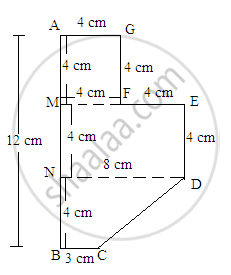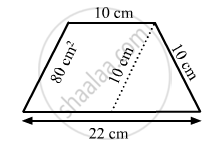Advertisements
Advertisements
Question
Find the area of the field shown in Fig. 20.39 by dividing it into a square, a rectangle and a trapezium.
Solution

From the above figure:
Area of the figure=(Area of square AGFM with sides 4 cm)+(Area of rectangle MEDN with length 8 cm and width 4 cm)+(Area of trapezium NDCB with parallel sides 8 cm and 3 cm and perpendicular height 4 cm
\[= (4\times4)+(8\times4)+[\frac{1}{2}\times(8+3)\times(4)]\]
\[= 16+32+22\]
\[ {= 70 cm}^2\]
APPEARS IN
RELATED QUESTIONS
Find the area, in square metres, of the trapezium whose bases and altitude is as under:
bases = 12 dm and 20 dm, altitude = 10 dm
Find the area, in square metres, of the trapezium whose bases and altitude is as under:
bases = 8 m and 60 dm, altitude = 40 dm
Find the area of a trapezium whose parallel sides are of length 16 dm and 22 dm and whose height is 12 dm.
The area of a trapezium is 1586 cm2 and the distance between the parallel sides is 26 cm. If one of the parallel sides is 38 cm, find the other.
Find the area of a trapezium whose parallel sides are 25 cm, 13 cm and the other sides are 15 cm each.
In Fig. 20.38, a parallelogram is drawn in a trapezium, the area of the parallelogram is 80 cm2, find the area of the trapezium.
Find the area of the trapezium ABCD in which AB || DC, AB = 18 cm, ∠B = ∠C = 90°, CD = 12 cm and AD = 10 cm.
The sunshade of a window is in the form of isosceles trapezium whose parallel sides are 81 cm and 64 cm and the distance between them is 6 cm. Find the cost of painting the surface at the rate of ₹ 2 per sq.cm
The perimeter of a trapezium is 52 cm and its each non-parallel side is equal to 10 cm with its height 8 cm. Its area is ______.
The area of a trapezium become 4 times if its height gets doubled.
